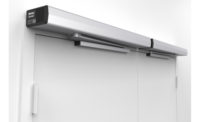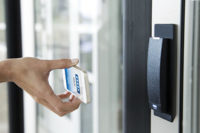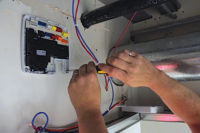Access control discussions today often center around the latest and greatest features, new technologies, integrations and high tech options. However, when a user goes to a door, what they see is more likely the door activation device. These unassuming pieces of hardware are undergoing some of the same shifts as other technologies in the security industry.
What is a door activation device? It is the button, sensor or reader that causes the door to open. It could be a traditional “mushroom” button, push plate, request-to-exit (REX) button or bar.
“An initiation device is any device used to open the door or lock the door,” says David Price, marketing manager, Camden Door Controls, Toronto.
Two of the biggest trends affecting door activation devices in recent years have been wireless and touchless technology.
The Hand-E-Wave from Essex Electronics, Carpinteria, Calif., is a hands-free switch with 24GHz Doppler radar technology, designed for use in hospitals, food processing plants and other areas where “no touch” switches are increasingly popular, says company president, Garrett Kaufman.
Dormakaba, Cambridge, Ontario, also has a popular wave button activation device, says Murray Lewin, senior product manager and site lead. “We are enjoying success with it, particularly in a hospital environment.”
These “frictionless” options are becoming increasingly popular in many vertical markets, Price adds. “There is no physical contact between the user and the switch, which helps prevent the spread of germs. That is why it is popular in hospitals. But it is also convenient in shipping areas where you may be carrying a load of boxes. We are starting to reach critical mass where they are becoming a common type of switch for both control of automatic doors and push-to-lock and other kinds of security functions. You can wave to lock and wave to exit.”
Another trend echoes a larger one in the security industry as a whole: wireless. One of the reasons wireless options are increasingly popular is the advancement of the technology itself, Price says. “In the past, wireless system reliability, lack of features and short battery life meant that installers would only use this when wiring was difficult. Now that wireless systems offer comparable reliability to wired systems and manufacturers can offer up to five years’ battery life, installers are using wireless to reduce installation costs by more than 50 percent.”
Issues with wireless in the past may have hurt adoption levels, but the industry is now at a point where new wireless technology, such as frequency hopping or spread spectrum, has made it a viable alternative for door control applications, Price adds.
No matter what type of device you use, there are several factors to be aware of when choosing and installing these customer-facing products.
1. Quality
For starters, Price says, make sure you choose a quality product.
“One of the biggest mistakes an installer can make is to assume that all makes of activation devices on the distributor’s shelf are the same or, if there is a difference, that it won’t affect their business,” Price says. “There are big differences in product features, quality, performance and value between brands — and that will have a direct impact on the installer’s profitability and the customer’s satisfaction.
“If you think about an access control installation from the end user’s perspective, they don’t see the $5,000 invested in the control panel and wiring. They rate the quality and performance of the installation based on the one thing they see and use every day — the $50 activation device. This is not where an installer should say that ‘second best’ is good enough.”
Kaufman recommends looking for rugged construction, especially in a setting like a hospital. “By installing ruggedized switch-activation devices, the dealer can expect to install it once and forget about it. The ruggedized nature of our switches reduces the impact of having to replace the product due to vandalism or every day heavy use.”
One good evaluation process is to purchase the products and use them at your office or do a side-by-side comparison between brands, prior to putting them in a customer’s site. Another thing to look for are ISO ratings, as well as manufacturer warranties to gauge the overall quality. “We not only offer a three-year replacement warranty, but also a two-for-one replacement warranty, which means that if our customers send me back a switch with a manufacturing defect I will replace it with two switches,” Price says.
2. Aesthetics
Consider how the button will look — something that is increasingly important to users and specifiers. The 6300 series low-energy operator from ASSA ABLOY, New Haven, Conn., features one of the slimmest profiles available, according to the company.
“This operator was designed to be mounted to low-profile architectural projects that help minimize what might otherwise be a visually unappealing aesthetic,” says a company spokesperson. “This was designed to be one of the most architecturally beautiful door activations on the market.”
3. Customer Expectations
One of the most important things Lewin recommends is that you put effort into making sure the customer expectations are met. “If there is a disconnect between what the owner is expecting and what they provide, there can be a huge gap.”
Door openings are getting more sophisticated and so are customer expectations, he says. The key for the dealer or installer is to make sure they get it right. “They need to know, are they connecting to a head end somewhere? Is there an access control system these devices need to be connected to? Are the openings being monitored and reported? Where is that information going?
“We should never go into access control without having a roundtable discussion with the owner or end user, the integrator and perhaps the manufacturer to understand how the product is going to work and is it going to work?”
4. Installation & Design
It is imperative that dealers and installers do their due diligence when it comes to designing and installing door activation devices.
“Poor planning and installation standards are the biggest issues we see,” says the ASSA ABLOY spokesperson. “Installers often forget to plan ahead for installation challenges or look into resource materials available to them. This results in them failing to make sure the product is installed level, correctly and on the right surface so that it will look right and operate properly.”
ASSA ABLOY and other manufacturers offer training classes, written guides and numerous resources to help. But it is up to the dealers and installers to seek out that help — or in some cases simply read the manual.
“We go to great lengths to provide installation manuals that are technical, but not over the top, to help an installer know what they are doing,” Lewin says. “More often than not, these are thrown away because they think they don’t need it. Installers think they know what they have, and then they put a wrong wire somewhere and send it back to us saying it is defective.”
Another thing Lewin stresses is to use the correct wires for the installation. “Should it be Cat 5 or Cat 6? Shielded? I have witnessed access control switches being installed with speaker wire because that was the only thing the guy had in his truck. That is a dangerous thing to do because it could backlash to the head end and actually blow it up.”
The bottom line, when it comes to door activation devices, is they are not “throw-away” items that require little thought. Like any piece of the access control system equation, they take proper planning, customer input and installation. After all, Price says, “The typical building occupant walks up to a REX switch and they hit it; if that product doesn’t work, it undermines the whole system.”
More Online
For more information on door activation devices and hardware, visit SDM’s website where you will find the following articles:
“Smarter Intelligent Locks and Hardware for the Intelligent Age”
www.SDMmag.com/locks-and-hardware-for-the-intelligent-age









